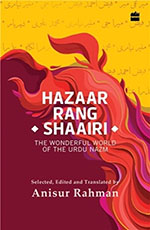Reporting on the stupendous footfall at Jashn-e-Rekhta recently, The New York Times reported, ‘That 300,000 people celebrated Urdu verse during a three-day festival was testament to the peculiar quality of language in India’ and the report was titled, ‘Where Romantic Poetry in a Fading Language Draws Stadium Crowds’. Even though Urdu poetry, in its entirety, is indeed not romantic, yet every time it is mentioned, it invariably invokes the idea of romance. The merit of Hazar Rang Shaairi is that it dispels the myth of Urdu poetry as being nearly synonymous with the romantic ghazal poetry in popular imagination and disabuses the reader of this false perception. It brings out the versatility and reach of the Urdu poetic imagination. It is also not perhaps out of context to point out that Urdu poetry is more about nazm, not ghazal, if one were to consider the enormous amount of masnavi, marsiya, qasida, rubai and so on—all forms of nazms.
Anisur Rahman’s is not a new name for the connoisseurs of Urdu and Urdu poetry in English translation. His earlier works, Fire and Rose: An Anthology of Modern Urdu Poetry (1995), and Hazaaron Khwahishein Aisi: The Wonderful World of Urdu Ghazals (2019), have had enthusiastic reception both in and outside the academic world. His contribution to the leading Urdu digital platform Rekhta is also not unknown. Given his proclivity and passion for poetry and translation, it is no surprise that Rahman chose to map the majestic world of Urdu nazm this time.

